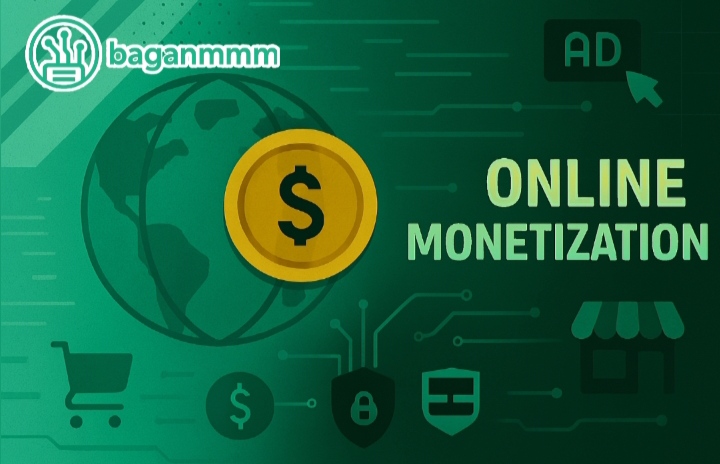Online Monetization in 2025
Smarter Strategies for Sustainable Income in the Creator Economy

The digital landscape in 2025 is more creator-friendly than ever but also more competitive. With over 500 million active content creators globally, monetizing your online presence requires more than just uploading content and hoping for ad revenue. It demands strategy, diversification, and a deep understanding of how audiences engage and convert.
Whether you’re a YouTuber, blogger, educator, or digital artist, this guide will walk you through the most effective monetization models of 2025 and how to use them to build a thriving, multi-stream income.
Creator Economy: A $500 Billion Opportunity
According to global surveys, the creator economy is growing rapidly and is projected to reach $500 billion by 2027. Platforms are competing to provide better monetization tools, while audiences are increasingly willing to directly support creators. However, with this growth come new challenges — creators must now think like entrepreneurs, balancing business strategy with content creation.
There are both personal creators and enterprise creators. As the number of creators has surged, platforms have also introduced stricter checks and reviews to ensure higher-quality content. This means creators must not only seize opportunities but also focus on producing valuable, high-quality content.
Monetization Strategies in 2025
1. Ad Revenue & Sponsorships
Traditional Method + Modern Strategy
Ad revenue and sponsorships remain foundational income streams for digital creators in 2025, but they have evolved. Success today depends less on raw views and more on audience quality, niche authority, and platform diversity.
Ad Revenue: Platform Breakdown
YouTube Partner Program (YPP)
- Earnings from display ads, skippable video ads, and bumper ads.Revenue depends on CPM (cost per thousand views), which varies by niche and region.
- Creators in finance, tech, and education niches earn 4–6× more than lifestyle vloggers.
TikTok Creator Rewards & Instagram Reels Bonuses
- Short-form platforms pay based on engagement and watch time.
- TikTok’s fund is highly competitive and favors viral content.
- Instagram bonuses depend on Reels performance and audience retention.
Blog & Website Ads
- Ad networks like Google AdSense, Mediavine, and AdThrive pay based on impressions and clicks.
- SEO and strong audience engagement are key to maximizing revenue.
- Niche blogs with evergreen content perform best.
Sponsorships: High Effort, High Reward
Sponsorships are brand partnerships where creators promote products or services in exchange for payment. In 2025, sponsorships are the most lucrative per-deal monetization method, especially on YouTube.
How to Attract Sponsors
- Build a loyal, engaged audience (brands value trust over follower count).
- Prepare a media kit with audience demographics, engagement stats, and past collaborations.
- Pitch brands that align with your niche and values.
Where to Find Deals
- Influencer platforms : AspireIQ, Upfluence, CreatorIQ
- Direct outreach : LinkedIn, email
- Brand marketplaces and affiliate networks
Sponsorship Formats
- YouTube integrations and product reviews
- Instagram posts and Stories
- Blog features with affiliate links
- Podcast shoutouts and newsletter placements
2025 Trends & Insights
- AdSense remains the primary income source for 28.6% of creators.
- YouTube creators earn 4× more from ads than TikTok and 6× more than Facebook.
- Brands now prioritize micro-influencers with niche authority over mega-followers.
- Crypto-based ad payouts and instant withdrawal tools (e.g., MilX) are gaining popularity.
This section covers the traditional method of ad revenue. As a creator, you may already be familiar with it, but there are still important points to keep in mind.
Today’s social media users are becoming more thoughtful and discerning, which means creators must focus on producing valuable content. To retain audiences, creators also need to understand and adapt to changing platform policies.
2. Affiliate Marketing
Passive Income, Personalized Strategy
Affiliate marketing remains one of the most powerful and scalable monetization methods in 2025 but it’s no longer just about dropping links. Today’s successful affiliates are content-driven strategists, blending trust, data, and automation to convert audiences into buyers.
How Affiliate Marketing Works
At its core, affiliate marketing means promoting a product or service and earning a commission when someone buys through your unique referral link. But in 2025, it’s evolved into a multi-platform, multi-format ecosystem.
Key Models:
- CPS (Cost Per Sale): Earn a percentage of each sale
- CPA (Cost Per Action): Earn when users complete a specific action (signup, download)
- Recurring Commissions: Monthly payouts for SaaS, memberships, or subscriptions
- Hybrid Models: Combine upfront bonuses with long-term revenue share
Top Affiliate Platforms in 2025
| Platform | Best For |
|---|---|
| Amazon Associates | Physical products, global reach, trusted brand recognition |
| Impact | Premium brands, influencer-friendly tools, flexible tracking |
| ShareASale | Niche products, small businesses, lifestyle and fashion creators |
| ClickBank | Digital products, high commissions, info-based niches |
| PartnerStack | SaaS tools, B2B platforms, recurring commissions |
| CJ Affiliate (Commission Junction) | Enterprise-level partnerships, global campaigns |
| Gumroad Affiliates | Creator-made products, e-books, templates, and courses |
Winning Strategies for 2025
According to ClickBank’s expert guide and G.Partners’ trend report, here are the affiliate strategies that actually work:
1. Native Advertising
- Use platforms like Taboola or Outbrain to run content-style ads
- Blend affiliate links into helpful articles or product reviews
2. Short-Form Social Media
- TikTok, Reels, and Shorts drive massive traffic to affiliate landing pages
- Use storytelling and product demos to build trust
3. YouTube Reviews & Tutorials
- Create evergreen content around product comparisons or how-tos
- Include affiliate links in descriptions and pinned comments
4. Email Marketing & Newsletters
- Build segmented lists and recommend products based on user behavior
- Use automation tools like ConvertKit or Beehiiv
5. Blogging + SEO
- Write keyword-rich articles targeting buyer intent
- Use comparison tables, pros/cons, and call-to-action buttons
6. Pinterest & Visual Search
- Create pins linking to affiliate blog posts or product pages
- Ideal for fashion, home, and lifestyle niches
7. Community Management
- Build niche forums, Discord servers, or Facebook groups
- Share affiliate links organically within trusted spaces
Compliance & Ethics
Affiliate marketing is under tighter regulation in 2025. To stay compliant:
- Always disclose affiliate relationships clearly
- Avoid misleading claims or fake reviews
- Respect user privacy and data protection laws (GDPR, CCPA)
This was an overview of Artificial Marketing, which was first introduced in 2025. Artificial Marketing is a profitable method for creators. However, unlike other ad revenue systems, it does not generate income based on views. Instead, you only earn profit when viewers purchase the products you tag.
That’s why it’s essential to have a quality audience. You also need to build strong personal branding. The products you tag must genuinely align with your audience’s interests and needs.
If you have a quality audience and can tag products that truly fit them, this can become a reliable source of extra income for you.
3. Selling Digital Products
Low Overhead, High Scalability Monetize What You Know
Selling digital products is one of the most profitable and flexible monetization strategies in 2025. Unlike physical goods, digital products require no inventory, shipping, or manufacturing and once created, they can be sold infinitely with minimal upkeep. Whether you’re a creator, educator, designer, or strategist, digital products let you package your expertise into assets that work while you sleep.
What Counts as a Digital Product?
Digital products are intangible goods delivered electronically. Popular formats include:
E-books & Guides: Educational, inspirational, or niche-specific content
Online Courses: Video-based learning hosted on platforms like Teachable or Thinkific
Printables: Calendars, planners, worksheets, coloring books
Templates: For Notion, Canva, Figma, resumes, pitch decks
Design Assets: Fonts, icons, mockups, LUTs, overlays
Software & Apps: Mobile tools, plugins, SaaS platforms
Memberships: Exclusive content, community access, or premium resources
Audio Products: Sound packs, meditation tracks, voiceover bundles
| Product Type | Difficulty | Earning Potential |
|---|---|---|
| Online Courses | Moderate | High — $60K+/year on platforms like Udemy or Teachable |
| E-books | Variable | Good — $1K+/month on Kindle or Gumroad |
| Printables | Easy | $100–$1,000/week depending on niche and platform |
| Membership Sites | Moderate | $200–$5,000/month once community is established |
| Templates & Kits | Easy–Moderate | High — especially for business, design, and productivity niches |
| Mobile Apps | High | Very High — scalable with subscriptions or in-app purchases |
Where to Sell Digital Products
Hosted Platforms:
- Gumroad: Simple storefront, great for creators
- Payhip: Sell e-books, courses, and memberships
- Teachable / Thinkific: Ideal for structured courses
- Podia: All-in-one platform for courses, downloads, and memberships
- Etsy: Surprisingly effective for printables and templates
- Shopify / WooCommerce: Full control with custom branding
Marketplaces:
- Creative Market: Design assets and templates
- Envato Elements: Stock media, plugins, and themes
- Amazon Kindle Direct Publishing (KDP): E-books and guides
- App Stores: For mobile apps and tools
Trends in 2025
- Micro-products (under $20) are booming fast to create, easy to sell
- AI-assisted creation is speeding up production of e-books, templates, and courses
- Subscription bundles are replacing one-off sales think Notion dashboards + monthly updates
- Mobile-first products (apps, audio packs, mobile templates) are dominating global markets
- Creator marketplaces are emerging platforms like Gumroad now offer discovery engines and affiliate layers
Selling digital products online can also increase your extra income. To do this successfully, you need to have a strong audience. You yourself must also understand and be skilled in these digital products. In addition, you should be able to explain them clearly to your audience, and the products must be genuinely useful and of good quality.
If you master these points, you can generate extra income through social media. This has also become one of the best income streams for creators in 2025.
4. Subscriptions & Memberships
Recurring revenue from loyal fans.
Platforms: Patreon, Ko-fi, YouTube Memberships, Substack
Offer tiers with perks: early access, behind-the-scenes, Q&A sessions
Build a fan community that supports you monthly
5. Creator Funds & Platform Bonuses
Direct payouts from tech giants.
- TikTok Creator Fund, Meta Bonuses, YouTube Shorts Fund
- Often based on views, engagement, and consistency
- Great for short-form creators and viral content
6. Merchandising & Brand Building
Turn your identity into a product.
- Sell branded apparel, mugs, stickers, or digital avatars
- Use platforms like Spring, Printful, or Shopify
- Build a brand that reflects your content and values
7. Freelancing & Consulting
Monetize your expertise.
- Offer services like writing, design, editing, or strategy
- Use platforms like Fiverr, Upwork, or direct outreach
- Package your skills into retainers or one-off gigs
Multi-Stream Monetization: The Smartest Path Forward
In 2025, relying on one income source is risky. The most successful creators use multi-stream monetization, combining 3–5 methods to stay resilient.
For example:
- YouTube ads + affiliate links + course sales
- Blog traffic + sponsorships + digital templates
- TikTok virality + merch + Patreon
Final Thought:
Online monetization in 2025 isn’t just about making money it’s about building value, trust, and independence. The tools are more powerful than ever, but success depends on how well you understand your audience, position your brand, and adapt to change.
Whether you’re just starting out or scaling up, treat your content like a business and your audience like partners in that journey.
Alice is the visionary behind Baganmmm Tech, a platform he founded with a passion for demystifying the complex world of technology. As the Lead Technologist, he's often found in his home lab – a cozy, wire-filled sanctuary where ideas are born and code is meticulously crafted. His infectious enthusiasm and knack for explaining intricate concepts make him the go-to expert for everything from web development to emerging tech trends.
